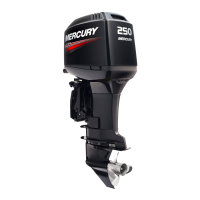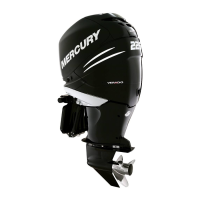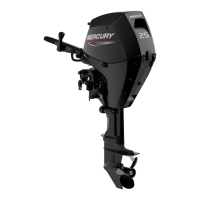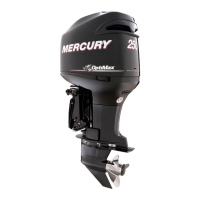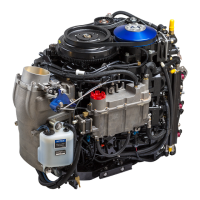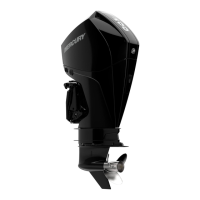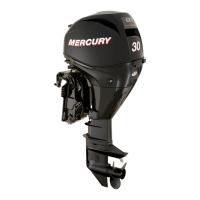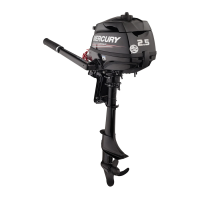

Do you have a question about the Mercury 2.5 and is the answer not in the manual?
| Fuel Induction System | Carburetor |
|---|---|
| Ignition | CDI |
| Starting | Manual |
| Steering | Tiller |
| Cylinders | 1 |
| Recommended Fuel | 87 Octane |
| Shaft Length | 15 in (381 mm) |
| Horsepower | 2.5 HP |
| Gear Shift | Forward, Neutral |
The limited warranty is transferable to a subsequent purchaser, but only for the remainder of the unused portion of the limited warranty.
Process for registering your product with Mercury Marine in the US and Canada for warranty coverage.
Steps for registering your product outside the US and Canada with Mercury Marine.
Details of the two-year limited warranty coverage for Mercury products sold in Europe.
Details of the one-year limited warranty for specific regions outside Europe.
Details of the three-year limited warranty specifically covering corrosion damage.
Clarifies common misunderstandings about what is and is not covered by warranty.
Lists specific items and conditions that are not covered by the limited warranty.
Outlines the operator's duties for safe operation and compliance with manual.
Guidance on reading the manual and understanding safety labels before use.
Warning about exceeding a boat's maximum horsepower limit and its consequences.
Explains the function and importance of the lanyard stop switch for safety.
Safety advice for preventing injuries to people in water near the boat.
Information about carbon monoxide poisoning and ventilation.
Guidance on choosing and installing accessories for the outboard.
Recommendations for safe operation, including flotation devices and obeying rules.
Instructions on where to find and record the outboard's serial number.
Technical specifications for the 2.5 and 3.3 HP models.
Instructions for mounting the outboard onto the boat's transom.
Guidance on how to carry the outboard motor.
Procedures for transporting the outboard when it's not mounted on a boat.
Important considerations for trailering a boat with the outboard attached.
Advice on the type and grade of gasoline to use for the outboard engine.
Specifies the recommended type of oil for mixing with fuel.
Instructions on the correct fuel-to-oil ratio for different stages of use.
Safety precautions and steps for filling the fuel tank.
Overview of the throttle, choke, and stop switch controls.
Instructions on how to tilt the outboard motor to the full up position.
How to adjust the outboard's tilt angle for optimal performance.
Essential checks to perform before starting the outboard engine.
Procedures for operating the outboard in cold weather conditions.
Recommendations for flushing and cleaning after use in salt or polluted water.
Instructions for the initial break-in period of the engine.
Step-by-step guide on how to start the outboard engine.
Procedure for safely shutting down the outboard engine.
How to operate the gear shift for forward and neutral positions.
Instructions for starting the engine using a spare starter rope.
General advice for maintaining the outboard's operating condition and safety.
Recommendation to use genuine Mercury parts for replacements.
Information about the emission certification label and owner responsibility.
Schedule of checks and maintenance tasks before, after, and periodically.
Steps for removing and reinstalling the top engine cowl.
How to clean and protect the outboard's exterior finish.
Procedure for flushing the engine's cooling system with fresh water.
Detailed steps for replacing the outboard's propeller.
Explanation of the anode's function and inspection/replacement.
Guide for inspecting and replacing the spark plugs.
How to adjust the engine's idle speed for proper operation.
Locations and procedures for lubricating various outboard components.
Instructions for checking and changing the gearcase lubricant.
Steps for properly draining the lubricant from the gearcase.
Specifies the volume of lubricant required for the gearcase.
Procedure for checking and refilling the gearcase lubricant.
Immediate service procedures required if the outboard becomes submerged.
Procedures for preparing the outboard for seasonal or prolonged storage.
Important considerations for the fuel system when storing the outboard.
Steps to protect the outboard's external parts during storage.
Procedures for protecting the internal engine parts during storage.
Gearcase maintenance procedures related to storage.
Correct orientation for storing the outboard to prevent damage.
Common causes and solutions when the engine fails to start.
Troubleshooting steps for an engine that runs unevenly.
Potential reasons for reduced engine performance and how to address them.
Guidance on returning the outboard to a local authorized dealer for service.
How to find and contact the nearest authorized dealer when traveling.
Where to direct questions about genuine replacement parts and accessories.
Steps to take if you need further assistance from Mercury Marine.
Contact information for Mercury Marine service offices in various regions.

